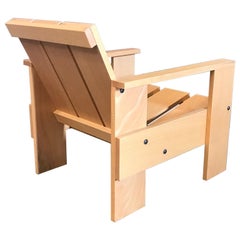Kratstoel Rietveld
Mid-20th Century Dutch De Stijl Living Room Sets
Pine
Recent Sales
Vintage 1930s Dutch De Stijl Lounge Chairs
Wood
A Close Look at de-stijl Furniture
It has been more than 100 years since the founding of the Dutch art and design movement known as De Stijl.
It was in October of 1917 that artist, architect and critic Theo van Doesburg released the first issue of De Stijl magazine. A platform for artists, designers and architects to express their revolutionary new ideas, the journal was a launching point for what would become an international movement. Meaning “the Style,” De Stijl was an attempt at pure abstraction — one centered on the use of primary colors and perpendicular lines as a utopian expression of a harmonious world.
Along with van Doesburg, the group’s most integral members were Bart van der Leck, Gerrit Rietveld and Piet Mondrian, whose geometric red, yellow, blue and black “Composition” paintings remain the most recognizable work of the movement. Mondrian used the term “neoplasticism” to describe the abstract art that he and his friends produced.
Not just an art movement, however, De Stijl also had a profound impact on modern design and architecture. It would go on to influence Bauhaus and the International Style of architecture. Although it was disbanded in 1931, De Stijl continues to inspire the popular imagination today, and De Stijl creators and their ilk are responsible for timeless works (some of which can be found on 1stDibs).
Made from two plywood plates and 15 connecting bars, the Red and Blue chair is a calling card of the De Stijl movement. Designed by architect Gerrit Rietveld, the chair is most often referred to as the Rietveld chair, likely because it didn’t actually get its signature De Stijl colors until the early 1920s.
Also designed by Rietveld, this asymmetrical side table was constructed for his first residential commission, the Rietveld Schröder House in Utrecht, which is now a Unesco World Heritage Site.
Mondrian is the De Stijl group’s most well-known member. His familiar black lines with red, yellow and blue blocks are still reproduced in artworks and products today.
Russian-American artist Ilya Bolotowsky was highly interested in the work of Piet Mondrian. A founding member of the New York–based American Abstract Artists — other founders included Ray Kaiser (later Eames) and Josef Albers — Bolotowsky was smitten with Mondrian’s pure geometric abstractions from the period when lived in New York. In this signed, untitled silkscreen print from around 1970, you can see Bolotowsky’s use of hard-edge vertical and horizontal lines, as well as primary colors, although he didn’t limit himself to this palette.
Mondrian is the De Stijl group’s most well-known member. His familiar black lines with red, yellow and blue blocks are still reproduced in artworks and products today. In the 1960s, Yves Saint Laurent designed the Mondrian Collection of cocktail dresses. This wall mirror by Italian manufacturer Rimadesio is among the many decor pieces created in the likeness of Mondrian.
On 1stDibs, find De Stijl lighting, De Stijl decorative objects and more.
Finding the Right seating for You
With entire areas of our homes reserved for “sitting rooms,” the value of quality antique and vintage seating cannot be overstated.
Fortunately, the design of side chairs, armchairs and other lounge furniture — since what were, quite literally, the early perches of our ancestors — has evolved considerably.
Among the earliest standard seating furniture were stools. Egyptian stools, for example, designed for one person with no seat back, were x-shaped and typically folded to be tucked away. These rudimentary chairs informed the design of Greek and Roman stools, all of which were a long way from Sori Yanagi's Butterfly stool or Alvar Aalto's Stool 60. In the 18th century and earlier, seats with backs and armrests were largely reserved for high nobility.
The seating of today is more inclusive but the style and placement of chairs can still make a statement. Antique desk chairs and armchairs designed in the style of Louis XV, which eventually included painted furniture and were often made of rare woods, feature prominently curved legs as well as Chinese themes and varied ornaments. Much like the thrones of fairy tales and the regency, elegant lounges crafted in the Louis XV style convey wealth and prestige. In the kitchen, the dining chair placed at the head of the table is typically reserved for the head of the household or a revered guest.
Of course, with luxurious vintage or antique furnishings, every chair can seem like the best seat in the house. Whether your preference is stretching out on a plush sofa, such as the Serpentine, designed by Vladimir Kagan, or cozying up in a vintage wingback chair, there is likely to be a comfy classic or contemporary gem for you on 1stDibs.
With respect to the latest obsessions in design, cane seating has been cropping up everywhere, from sleek armchairs to lounge chairs, while bouclé fabric, a staple of modern furniture design, can be seen in mid-century modern, Scandinavian modern and Hollywood Regency furniture styles.
Admirers of the sophisticated craftsmanship and dark woods frequently associated with mid-century modern seating can find timeless furnishings in our expansive collection of lounge chairs, dining chairs and other items — whether they’re vintage editions or alluring official reproductions of iconic designs from the likes of Hans Wegner or from Charles and Ray Eames. Shop our inventory of Egg chairs, designed in 1958 by Arne Jacobsen, the Florence Knoll lounge chair and more.
No matter your style, the collection of unique chairs, sofas and other seating on 1stDibs is surely worthy of a standing ovation.

